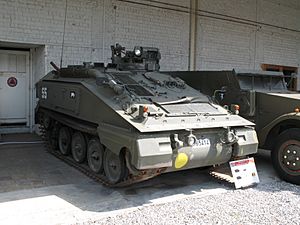Osnabrück mortar attack facts for kids
Quick facts for kids Osnabrück mortar attack |
|
|---|---|
| Part of the Troubles | |

A Spartan armoured carrier, a type of vehicle deployed at Osnabrück as part of the 4th Armoured Brigade
|
|
| Location | Osnabrück, Germany |
| Coordinates | 52°18′1″N 7°58′59″E / 52.30028°N 7.98306°E |
| Date | 28 June 1996 18:50 (UTC+01:00) |
| Target | British Army Quebec barracks |
|
Attack type
|
Mortar |
| Deaths | 0 |
|
Non-fatal injuries
|
0 |
| Assailants | Provisional IRA |
The Osnabrück mortar attack happened on June 28, 1996. It was an attack by a group called the Provisional Irish Republican Army (IRA) against the British Army's Quebec Barracks in Osnabrück, Germany. The IRA used special homemade bombs called mortars in this attack.
Contents
Why the Attack Happened
The Troubles and Peace Talks
In the early 1990s, the main groups involved in the Troubles (a conflict in Northern Ireland), including the British Government and the IRA, realized they couldn't win by fighting alone. The IRA thought they could achieve their goals better through talking and negotiations. Because of this, the IRA announced a "permanent ceasefire" on August 31, 1994. This meant they would stop fighting.
End of the Ceasefire
However, the IRA ended this ceasefire on February 9, 1996. They said it was because Sinn Féin, a political party linked to the IRA, was not allowed to join the peace talks. To show they were ending the truce, they set off a large bomb in London. This bomb caused a lot of damage to buildings and sadly, two people died, even though the IRA gave a warning beforehand. A few months later, in June 1996, another large bomb caused huge damage in Manchester city centre.
The IRA carried out these attacks in 1996 and 1997 to gain a stronger position in their talks with the British government.
The Attack Itself
How the Attack Unfolded
The attack happened at 6:50 PM local time. Three large mortar bombs, known as "Mark 15" bombs, were fired from an open Ford Transit van. Each bomb contained over 81 kilograms (180 pounds) of explosives.
A former British Army engineer named Michael Dickson had changed the van. He built the special platform inside the van and aimed the tubes that launched the bombs towards the barracks. The tubes were securely attached to the van's floor and hidden under covers.
Impact of the Bombs
Two of the bombs landed outside the barracks fence and did not explode. But the third bomb exploded about 18 meters (20 yards) inside the base. It left a large hole in the ground near a petrol station. Luckily, no fire started. However, the explosion damaged several buildings, cars, and military vehicles. The damage was described as "substantial."
There were 150 soldiers inside the barracks when the attack happened, but no one was hurt. The attackers left an explosive device in the van to destroy evidence, but it didn't work. Because the van was still intact, its license plates helped police trace it back to Yorkshire in England.
The Attackers
The IRA group involved in this attack had five members, including two women. They had rented a holiday home in northern Germany where they built the mortar launchers. Michael Dickson, who modified the van, later said in court that he had no experience with explosives during his time in the British Army's Royal Engineers. He had served at British bases in Germany but never in Northern Ireland. Two other people, Róisín McAliskey and Jimmy Corrie, were also thought to be part of this group. The IRA's main goal with these attacks was to set up a lasting presence in Europe.
What Happened After
Reactions to the Attack
John Major, who was the Prime Minister of the United Kingdom at the time, said that the attack showed how the IRA and Sinn Féin were separating themselves from the peace process. John Bruton, the leader of Ireland, called the IRA's actions "utterly pointless."
Changes in Peace Talks
Before this attack, the British government had refused to talk publicly with Sinn Féin until the IRA gave up its weapons. However, after the Labour Party came to power in 1997, they were willing to include Sinn Féin in peace talks even before the IRA handed over its weapons. This condition was officially removed in June 1997.
Arrests and Sentences
Michael Dickson was arrested in December 2002 at Ruzyně International Airport in the Czech Republic. He was wanted for the 1996 mortar attack. He was sent to Germany and sentenced to six and a half years in prison for trying to cause harm and setting off an explosion. He served 27 months of his sentence in a high-security prison in Germany before being released. Róisin McAliskey successfully fought against being sent to Germany for the attack.
See also
- 1985 Newry mortar attack
- 1994 British Army Lynx shootdown
- Barrack buster
- Chronology of Provisional Irish Republican Army actions (1990–1999)
- Downing Street mortar attack


